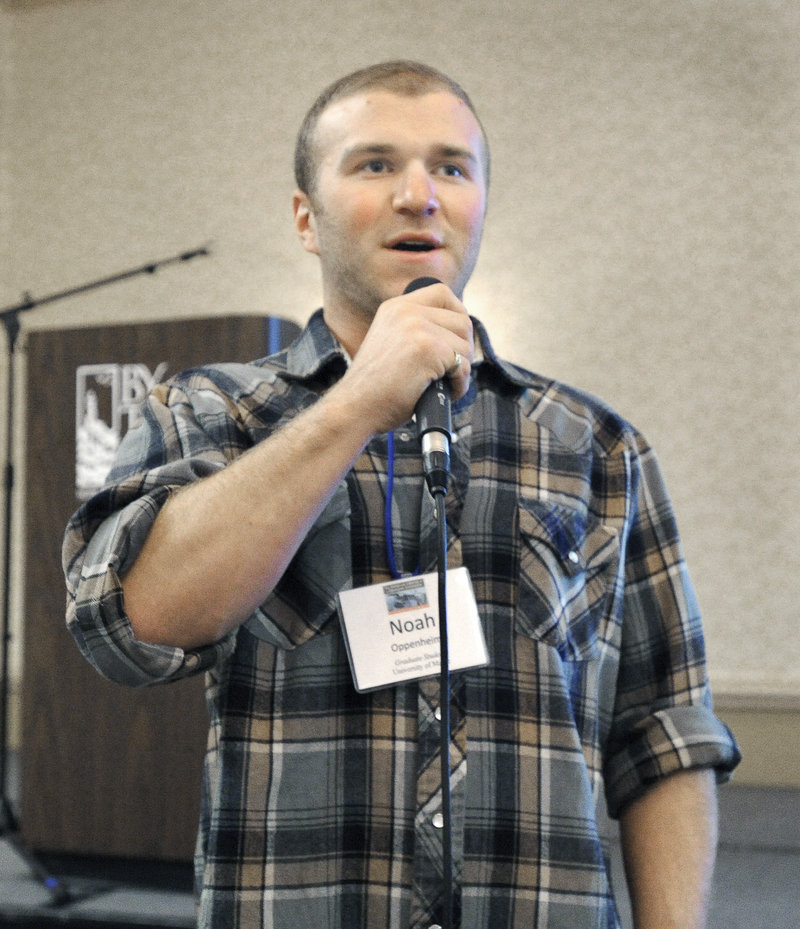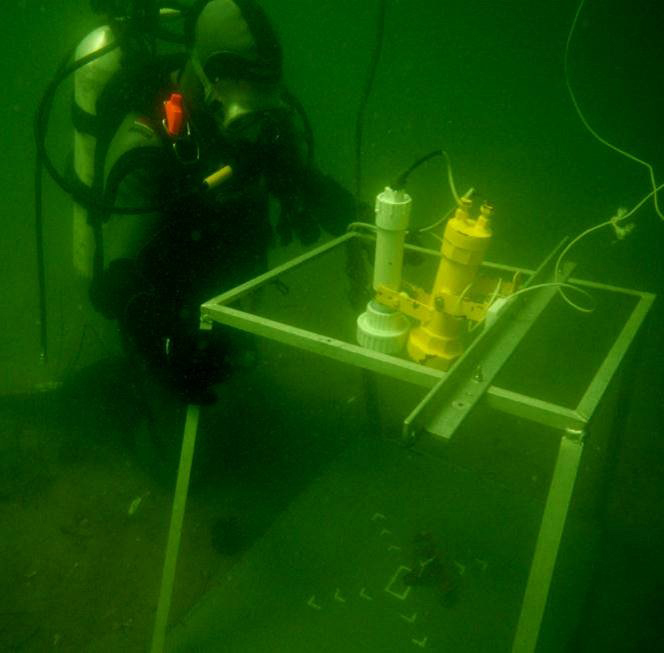One minute, Noah Oppenheim was firing up his camera on the ocean floor just off Pemaquid Point in the midcoast of Maine. The next, he was the first human witness to an underwater crime in progress.
“I was blown away,” Oppenheim, 25, said during a break this week at The American Lobster in a Changing Ecosystem, a four-day symposium of marine scientists at the Holiday Inn by the Bay in Portland. “I had no idea this was coming — absolutely no idea.”
He’s talking about lobsters eating their young.
At night, when nobody’s looking.
Or so they thought.
We hear a lot these days about Maine’s brain drain, that excruciating exodus of our best and brightest young people from their home state to, well, anywhere but Maine.
Then along comes a young scientist-in-training like Oppenheim and suddenly the future doesn’t feel quite so bleak.
He grew up in Falmouth, graduated from Waynflete School in Portland in 2005 and spent seven years attending college and working on the West Coast. Now he’s enrolled in a dual master’s program — in marine biology and fisheries policy — at the University of Maine.
And on Wednesday, Oppenheim took a deep breath and delivered his first-ever presentation at a scientific conference. His topic: “Cannibals by night? Density-dependent feeding in the Gulf of Maine’s lobster population.”
(Think Tru-TV’s “Top 20 Most Shocking” videos — only with claws.)
“It’s my honor to be this much in the loop,” Oppenheim said as more than 100 scientists from New England and Canada, including his own mentors from UMaine, milled about the conference organized by the university’s Maine Sea Grant College Program.
“Noah fits my lab perfectly,” said Rick Wahle, a professor in UMaine’s School of Marine Sciences who is Oppenheim’s adviser. “He’s got a great heart and is very enthusiastic about his work.”
Which brings us back to the lobsters.
Back in the summer of 2009, just before his senior year at Reed College in Portland, Ore., Oppenheim landed a National Science Foundation “Research Experience for Undergraduates” grant through the Bigelow Laboratory for Ocean Sciences in East Boothbay.
Through Wahle, who worked at Bigelow at the time, he’d become acquainted with research on predators of juvenile lobsters — mostly cod, other groundfish and the occasional crab — done by UMaine Professor Robert Steneck in the 1980s.
Back in those days, there was no shortage of ocean dwellers that considered juvenile lobsters the perfect appetizer. But as speaker after speaker at this week’s conference noted, the groundfish off Maine’s coast are long gone and thus the lobsters, with no more “top-down” predators to keep them on the run, are everywhere.
“So this begs the question: How have top-down trophic dynamics of juvenile lobsters changed since these previous assessments?” Oppenheim asked his standing-room-only audience.
Translation: Who down there, if anyone, is still scarfing down the baby lobsters?
Donning their scuba gear, Oppenheim and Wahle dived in off Pemaquid Point and set up their 30-foot-deep observation platform: an infrared, underwater camera mounted on a four-legged platform over a window screen resting on the bottom. Secured to the screen was an 8-inch tether with a small harness on the end. Into the harness Oppenheim placed a juvenile lobster — prevented by the tether from going beyond the camera’s narrow range.
“We were hoping just to see that maybe they were being untouched or that perhaps there were still fish and maybe there was just a different predator assemblage,” explained Oppenheim.
Translation: He expected hours of boring video. So boring that as he watched what was going on from the boat above that first night, Oppenheim eventually fell asleep.
Meanwhile, down below, all hell broke loose. Not once, but over and over as Oppenheim repeated the experiment 18 times: Little lobster crawls around in circles minding his own business. Big lobster moves in and, with lightning speed, swallows the juvenile whole.
And in one case, it got even better (except, of course, for the little guy in the harness): Big lobster gets chased off by an even bigger lobster who then has the small fry all to himself.
“It was mind-blowing,” said Oppenheim. “It told a much more interesting story than I was ever hoping to see.”
Now as any lobsterman will tell you — and more than a few have told Oppenheim — it’s by no means uncommon for lobsters to make mincemeat out of one another within the confines of a trap.
But this was different. Never before had lobsters been caught cannibalizing when not behind bars.
“What he sees is very real,” said Steneck, who did similar research (also with cameras) more than two decades ago and sat in on Oppenheim’s 15-minute presentation.
Back when he had his eye on them, Steneck noted, “they weren’t being eaten” by their elders.
Meaning?
“We’re looking at a different world,” Steneck replied.
Oppenheim’s discovery, by his own admission, is at best preliminary: The real proof that it’s a lobster-eat-lobster world down there will come only after he dispenses with the tethers and finds a way to see whether a juvenile lobster can actually escape the nighttime cannibals if given the chance.
“But what nobody has recognized is this random infanticide — the cannibalism that is occurring in the field in situ (in a fixed place),” he told his rapt audience.
Oppenheim’s scientific debut was, alas, not without its glitches. His video froze at several points, deflating what was supposed to be his must-see-TV moment.
“This one’s the fight,” he promised, the sympathetic crowd chuckling as he frantically tried to get the video moving again. “You want to see this.”
Still, balky laptop aside, you couldn’t listen to this up-and-coming researcher without marveling at a few equally important revelations.
A kid who moved clear across the country could have stayed out there; after graduating from Reed, Oppenheim spent two years in Alaska working as a groundfish observer for the National Marine Fisheries Service and as a summer deckhand aboard a commercial salmon gillnetter.
Instead, he came home. And when he finishes his three-year, double master’s program, home he plans to stay.
“I love the setting. I love the seasons. I love the ocean,” Oppenheim said. “And career-wise, I love the opportunity to stay.”
Without a tether.
Columnist Bill Nemitz can be contacted at 791-6323 or at:
bnemitz@mainetoday.com
Copy the Story Link
Send questions/comments to the editors.





Success. Please wait for the page to reload. If the page does not reload within 5 seconds, please refresh the page.
Enter your email and password to access comments.
Hi, to comment on stories you must . This profile is in addition to your subscription and website login.
Already have a commenting profile? .
Invalid username/password.
Please check your email to confirm and complete your registration.
Only subscribers are eligible to post comments. Please subscribe or login first for digital access. Here’s why.
Use the form below to reset your password. When you've submitted your account email, we will send an email with a reset code.